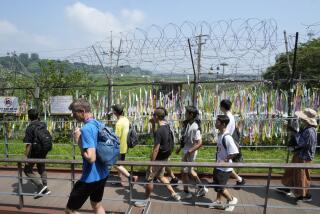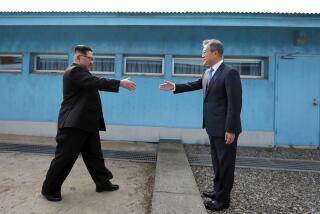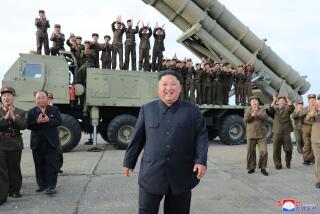Engaging Pyongyang Is Route to Stability
South Korean President Kim Dae Jung’s visit to the U.S. has put the focus on how to manage an increasingly desperate North Korea. Since assuming office in February, Kim has indicated that he intends to break the Cold War mentality that has stymied progress on the Korean peninsula for the past 45 years and implement a bold new policy toward the North--a policy based on engagement. The U.S. should support his initiative and take steps of its own to promote engagement that moves the peninsula, home to 37,000 U.S. troops, toward greater stability. There are three ways the U.S. can do this.
* Issue a statement that Washington does not seek the North’s collapse. In his inaugural address, Kim stated that his government, which sits only 30 miles from the DMZ, neither seeks to absorb the North nor actively promote its collapse. Washington, 7,000 miles farther away, should do the same.
Kim’s call for reconciliation was not a rash statement made for political effect. It was based on the reality that pursuing a policy of collapse is futile. Barring unforeseen events, neither Kim Jong Il, the North’s reclusive leader, nor his regime is likely to disappear in the near future. Even if the situation in the North should change, neighboring China is likely to offer aid that ensures its survival.
Stating clearly that the U.S. does not actively seek the North’s collapse (while also recognizing that there is no moral equivalency between the North and South) represents the most sensible approach toward promoting stability. Confronted with a positive statement of this nature, it would be more difficult for North Korea’s military to assume an aggressive posture.
* Greater engagement with the North. Issuing a statement that the U.S. does not seek the North’s collapse will only bring meaningful change if it is followed with a series of initiatives that seek to promote greater engagement, particularly in the economic arena.
To this end, the U.S., on a case-by-case basis, should lift economic sanctions imposed on North Korea as a result of the Trading With the Enemy Act. Allowing investment will force the North to learn more about our economic system and its benefits. One requirement that could be placed on lifting sanctions is that investment in the North must be in the form of U.S.-South Korean joint ventures.
The case for lifting sanctions has some strong proponents. Since his election, Kim Dae Jung has boldly increased the amount and type of investments South Korean firms can make in the North and has suggested that Washington lift sanctions.
* Support for existing initiatives. Policy toward North Korea in the pre-Kim Dae Jung era was not without success. Four-party peace talks to replace the truce that stopped the Korean War with a formal peace treaty began last year. The talks include North and South Korea, the U.S. and China. Shortly after these talks began, Pyongyang and Seoul resumed direct, bilateral dialogue in Beijing.
Similarly, the Korean Peninsula Energy Development Organization has been a success. Founded by the U.S., South Korea and Japan to implement portions of the landmark 1994 U.S.-North Korean Agreed Framework (in which Pyongyang agreed to scrap its suspect nuclear program in exchange for two proliferation-resistant nuclear reactors), KEDO has formed a professional relationship with the North. Working on the ground in North Korea and across the table from in New York, KEDO and North Korea have signed scores of internationally binding agreements that have allowed hundreds of South Koreans to travel to the North for the nuclear project. KEDO’s prime contractor for the project is a South Korean firm. This means that at the height of construction, thousands of South Koreans will work side by side with thousands of North Koreans, building not only safer nuclear reactors, but greater understanding and, it is hoped, mutual confidence.
These and other initiatives signal an acknowledgment of necessity, if not desire, by the North to engage. As such, they deserve the continued political and, in the case of KEDO, financial support of the administration and Congress
Managing North Korea is a very difficult task. The situation remains precarious and deterrence must remain the foundation of the U.S.-South Korean approach to the North. That said, the combination of Pyongyang’s increasing desperation and Kim Dae Jung’s refreshing vision presents an opportunity that Washington and Seoul must not let pass.
More to Read
Sign up for Essential California
The most important California stories and recommendations in your inbox every morning.
You may occasionally receive promotional content from the Los Angeles Times.










